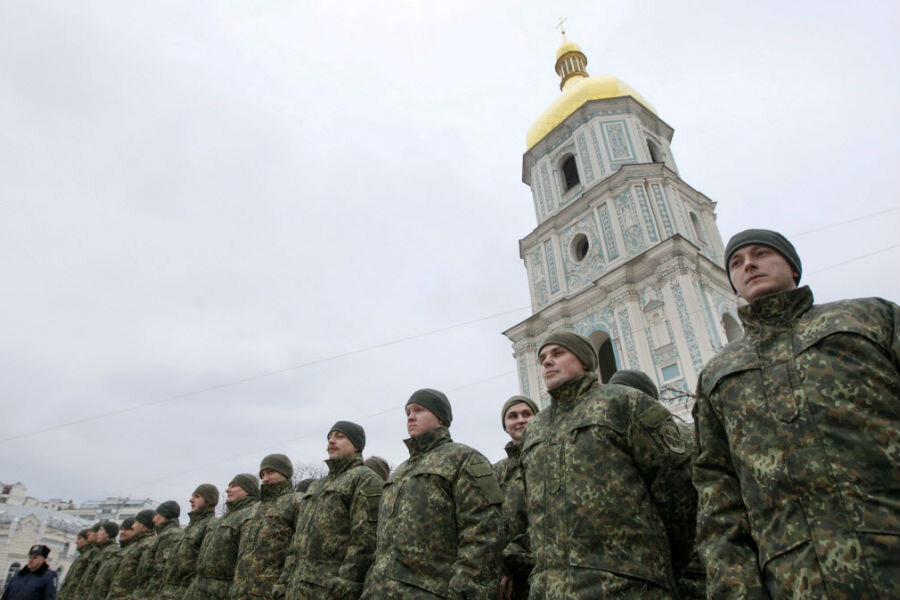Why Washington might be shifting toward sending arms to Ukraine
Loading...
| Washington
The Supreme Allied Commander in Europe, Gen. Philip Breedlove, is reportedly pushing a plan for the United States to provide weapons to Ukrainian forces to fight Russian-backed rebels.
Now, a new report from some heavy-hitters in Washington’s top think tanks argues that arming Ukraine may be the best way to help bring the crisis to a peaceful end. The report suggests that a stronger Ukrainian military “will increase the prospects for negotiation of a peaceful settlement.”
The push comes amid a growing sense in Washington that the current path in Ukraine is not helping to defuse the situation. Efforts to negotiate a settlement have fallen apart, and Russia has become increasingly aggressive.
The only way to “impose costs” on Russian President Vladimir Putin and force him to the negotiating table is through an influx of arms, some say. But others worry that such a move could backfire and instead only intensify the conflict and a new cold war.
Clearly, however, Washington is growing restless with the current arc of the conflict and is wrestling with new ways forward.
“We don’t want a new cold war. This isn’t about puffing up our chests and pushing back on Putin,” says Julianne Smith, a director of the Strategy and Statecraft Program at the Center for a New American Security (CNAS). “It’s extremely delicate, dangerous, and risky – but for all those reasons people feel like we’ve got to come up with some new play. We’ve got to walk him back to the negotiating table.”
Ms. Smith calls the report a “shift in the tide and the debate in Washington.”
Last summer, “There was this argument that restraint had value,” she says. “There was a belief that if we didn’t overreact, then we would in turn prevent Mr. Putin from overreacting.”
Yet that movement has fallen apart, and Russia has “upped its game,” she adds, and continued to back rebels in Ukraine.
A collaboration with influential think tanks including CNAS, the Atlantic Council, and Brookings Institution, the report recommends that the United States government give Ukraine $1 billion in military assistance “as soon as possible” this year, as well as “$1 billion” in 2016 and 2017.
With this money, Ukrainian fighters against Russian-backed separatists will be able to buy drones, armored Humvees, and medical equipment, the report points out.
It will also buy “lethal defensive military assistance,” to include anti-armor missiles to be used against “the large numbers of armored vehicles that the Russians have deployed.”
Providing such weapons “is not inconsistent with the search for a peaceful, political solution,” the report argues. “It is essential to achieving it.”
This reflects current thinking, says Smith, who was not an author of the report.
“Why should the west continue to hold back from issuing some sort of tougher response, especially when we have very specific requests from friends in Ukraine saying they need specific lethal assistance?” she says.
"The bottom line is that all of our patience has worn thin. We’ve thrown a lot of diplomacy towards Ukraine, and we don’t have a lot to show for it.”
Some analysts say that patience might have only made things worse, with Mr. Putin pressing Russia's advantage.
“There are those of us who think that the proposition of not doing enough [to aid Ukrainian fighters] is serving as a form of provocation,” says Jeffrey Mankoff, deputy director of the Russia and Eurasia Program at the Center for Strategic and International Studies. “The escalation that we’re trying to prevent is taking place anyway, so it’s not as if avoiding some of these decisions is going to help.”
An influx of arms would “impose costs” on Putin – Pentagon parlance for killing his people – and perhaps force him to the negotiating table by tapping into the same “sensitivity to casualties that undermined the Soviet war in Afghanistan and the Russian war in Chechnya,” Dr. Mankoff adds.
But it could also help Putin mobilize the Russian population against America and risk making a bad conflict worse.
For example, Russia is an “indispensable” partner in Iranian nuclear negotiations and in dealings with Syria, notes Smith, who was deputy national security adviser to Vice President Joe Biden from 2012 to 2013. “They are a nuclear-armed power with tremendous influence.”
A desperate Russia could also lash out in unpredictable ways,” she notes. Putin could become more meddlesome in Ukraine or try to break up Moldova, parts of which have a significant population of ethnic Russians.
“There are all sorts of moves he can make. He’s got a pretty rich menu – the question is whether he’s going to use it anyway, regardless of what we do,” Smith says.
“Half the people say this is the last thing that’ll get him back, the other half are saying maybe it will,” Smith adds. “I don’t think any author of this report – no one – will tell you with certainty that it’s going to work.”
Yet the combination of a collapsing Russian economy and the prospect of US arms there “does focus one’s mind,” she adds. “So the thinking is, ‘Let’s take that risk and see if it gets him there.’ ”







